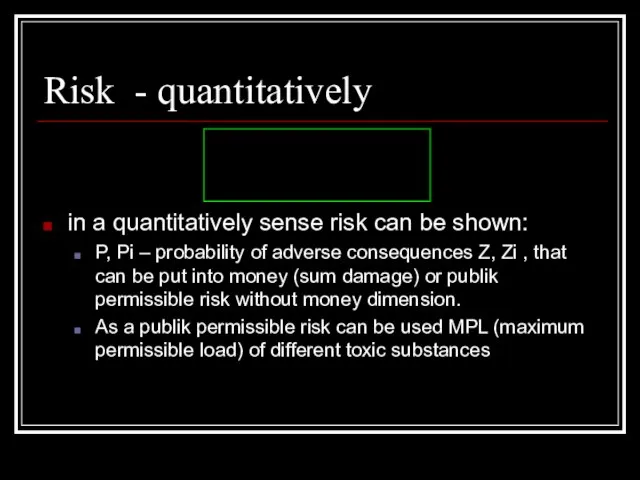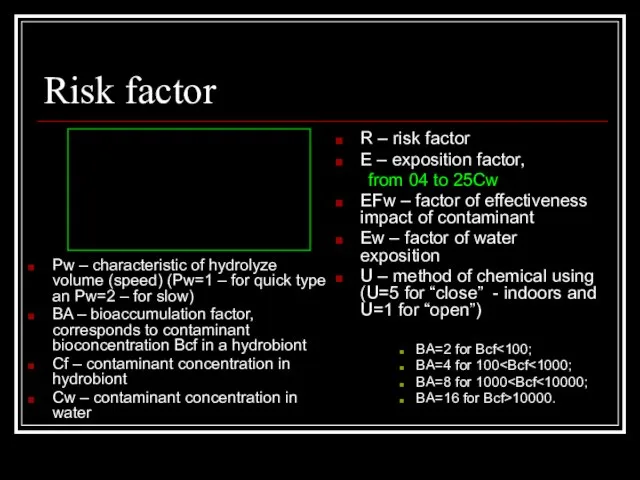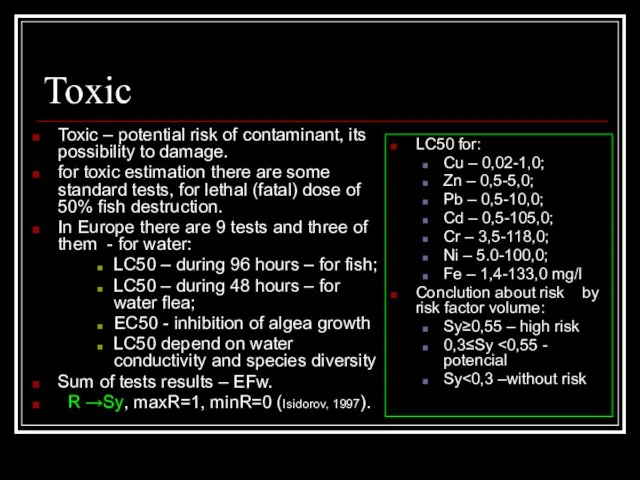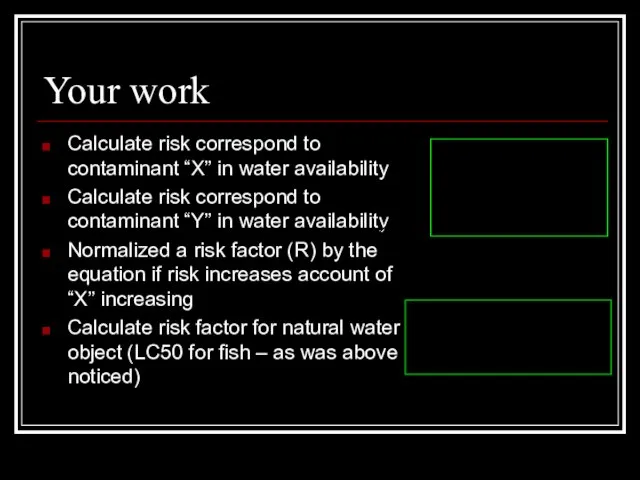Содержание
- 2. Risk Risk –possibility of hazard realization , or expected value of damage due to, for example,
- 3. Risk - quantitatively in a quantitatively sense risk can be shown: P, Pi – probability of
- 4. Risk factor Risk factor – has dimension and can be show by: Risk=Exposition * Toxic Exposition
- 5. Risk factor Pw – characteristic of hydrolyze volume (speed) (Pw=1 – for quick type an Pw=2
- 6. Toxic Toxic – potential risk of contaminant, its possibility to damage. for toxic estimation there are
- 7. Your work Calculate risk correspond to contaminant “X” in water availability Calculate risk correspond to contaminant
- 9. Скачать презентацию
Слайд 2Risk
Risk –possibility of hazard realization , or expected value of damage due
Risk
Risk –possibility of hazard realization , or expected value of damage due

Risk can NOT be measurement by technical methods
in a qualitative sense risk is characterized by adverse consequences nature
in a quantitatively sense risk is characterized by probability of their beginnings
Слайд 3Risk - quantitatively
in a quantitatively sense risk can be shown:
P, Pi
Risk - quantitatively
in a quantitatively sense risk can be shown:
P, Pi

As a publik permissible risk can be used MPL (maximum permissible load) of different toxic substances
Слайд 4Risk factor
Risk factor – has dimension and can be show by:
Risk=Exposition *
Risk factor
Risk factor – has dimension and can be show by:
Risk=Exposition *

Exposition – volume of contaminant for one biological target
Risk management - decision about contaminant using or putting a veto upon it, limitation its production, preparation of special corresponding documentation
Слайд 5Risk factor
Pw – characteristic of hydrolyze volume (speed) (Pw=1 – for quick
Risk factor
Pw – characteristic of hydrolyze volume (speed) (Pw=1 – for quick

BA – bioaccumulation factor, corresponds to contaminant bioconcentration Bcf in a hydrobiont
Cf – contaminant concentration in hydrobiont
Cw – contaminant concentration in water
R – risk factor
E – exposition factor,
from 04 to 25Cw
EFw – factor of effectiveness impact of contaminant
Ew – factor of water exposition
U – method of chemical using (U=5 for “close” - indoors and U=1 for “open”)
BA=2 for Bcf<100;
BA=4 for 100
Слайд 6Toxic
Toxic – potential risk of contaminant, its possibility to damage.
for toxic estimation
Toxic
Toxic – potential risk of contaminant, its possibility to damage.
for toxic estimation

In Europe there are 9 tests and three of them - for water:
LC50 – during 96 hours – for fish;
LC50 – during 48 hours – for water flea;
EC50 - inhibition of algea growth
LC50 depend on water conductivity and species diversity
Sum of tests results – EFw.
R →Sy, maxR=1, minR=0 (Isidorov, 1997).
LC50 for:
Cu – 0,02-1,0;
Zn – 0,5-5,0;
Pb – 0,5-10,0;
Cd – 0,5-105,0;
Cr – 3,5-118,0;
Ni – 5.0-100,0;
Fe – 1,4-133,0 mg/l
Conclution about risk by risk factor volume:
Sy≥0,55 – high risk
0,3≤Sy <0,55 - potencial
Sy<0,3 –without risk
Слайд 7Your work
Calculate risk correspond to contaminant “X” in water availability
Calculate risk
Your work
Calculate risk correspond to contaminant “X” in water availability
Calculate risk

Normalized a risk factor (R) by the equation if risk increases account of “X” increasing
Calculate risk factor for natural water object (LC50 for fish – as was above noticed)
 Руководство гражданской обороной в РФ
Руководство гражданской обороной в РФ Classroom language
Classroom language  Презентация на тему Качественные прилагательные 6 класс
Презентация на тему Качественные прилагательные 6 класс США 1 часть
США 1 часть Информация Наш сайт «Развивающие игры с ребенком от года и старше» Источник фотографий – Интернет. Источник звуков – коллекция Micr
Информация Наш сайт «Развивающие игры с ребенком от года и старше» Источник фотографий – Интернет. Источник звуков – коллекция Micr Перевод чисел в позиционных системах счисления
Перевод чисел в позиционных системах счисления презентация
презентация Досвід роботи Місюри Т.М.
Досвід роботи Місюри Т.М. Правильно выбранная профессия-счастливое будущее!
Правильно выбранная профессия-счастливое будущее! Профессиональная проба
Профессиональная проба Информационная система«Культурное наследие России»
Информационная система«Культурное наследие России» Почти одновременно с Эскиролем английский врач Причард дал подробное и основанное на изучении большого материала из мира душевно
Почти одновременно с Эскиролем английский врач Причард дал подробное и основанное на изучении большого материала из мира душевно Кафедры оптической физики и современного естествознания Санкт-Петербург 2011г.
Кафедры оптической физики и современного естествознания Санкт-Петербург 2011г. Консультация аллерголога-иммунолога
Консультация аллерголога-иммунолога Армейский чемоданчик
Армейский чемоданчик Эволюция архитектур систем статистики
Эволюция архитектур систем статистики Сочинение по картине И.И.Левитана «Золотая осень»
Сочинение по картине И.И.Левитана «Золотая осень» Объекты розничной торговли
Объекты розничной торговли Поиск облика административного здания
Поиск облика административного здания Токарно-винторезный станок (ТВ4)
Токарно-винторезный станок (ТВ4) Управление проектами в Системных Интеграторах Практическое использование Turbo Resource Tracker
Управление проектами в Системных Интеграторах Практическое использование Turbo Resource Tracker Определение положения деталей местности по видео Дмитрий Маракасов OpenStreetMap
Определение положения деталей местности по видео Дмитрий Маракасов OpenStreetMap  Андрі Файоль, як видатний управлінець
Андрі Файоль, як видатний управлінець Традиционные персонажи празднования святочных обрядов
Традиционные персонажи празднования святочных обрядов Мероприятия в шатрах
Мероприятия в шатрах Итоги 2019-2020 учебного года
Итоги 2019-2020 учебного года Общение с детьми дошкольного возраста
Общение с детьми дошкольного возраста Защита прав участников рынка: как обезопасить себя и своих клиентов
Защита прав участников рынка: как обезопасить себя и своих клиентов